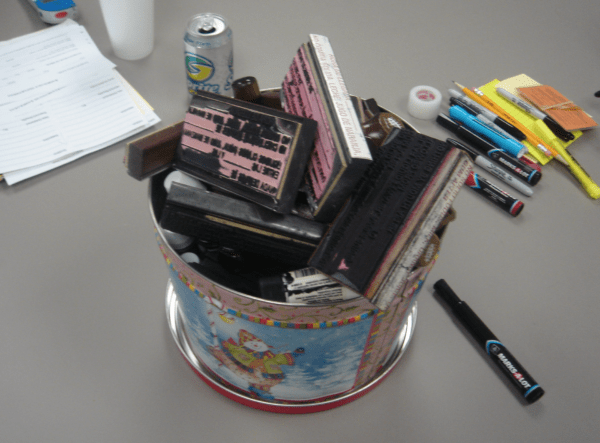I haven't read it, but Marie Kondo's book The Life-Changing Magic of Tidying Up: The Japanese Art of Decluttering and Organizing has been a pop-culture phenomenon the past few years.
I've seen some compare her process to the Lean practice of “5S.”
Kondo says you should only keep an item if it “sparks joy.”
Here is a “Lean Meme” created by my friend Ryan:

OK, if your boss doesn't spark joy, you might not be able to get rid of them, but you can find a different role or quit and leave for a different organization (and hope to find a leader who sparks joy).
Hear Mark read this post — subscribe to Lean Blog Audio
There is a funny connection to the word “joy” as something that W. Edwards Deming talked about.
“People are entitled to joy in work.”
W. Edwards Deming
Contemporary leaders like Rich Sheridan work hard to create a joyful workplace.
The 5S “sort” threshold or criteria in a workplace is more about whether an item is useful or not. When I've helped hospitals with 5S, we might, for example, find utility rooms cluttered up with broken commodes, outdated wheelchairs, etc. These items probably don't “spark joy” — but they are clearly in the way and just taking up space that could be better used in other ways.

This next photo shows a whole bucket full of stamps that were outdated and not needed in an MRI scheduling area. These did not spark joy. They were thrown out.

The long-running show Family Guy is something I watch regularly. In a recent episode, they parody Marie Kondo. The local news station's Japanese reporter Tricia Takanawa is on a local talk show to promote her book called Throw it Away.
Here's a clip where she explains the approach and Lois Griffin, sitting in the studio audience reacts with enthusiasm. She's inspired.
Tricia: It's called Throw it Away: The Life-Improving Art of Decluttering. People nowadays own too much stuff. I am encouraging them to throw it away.
Host: Genius! So just throw everything out?
Tricia: Not quite. If it kindles joy, you keep it. But, if no joy, you throw it away. It's very simple. I came up with it after hiking to the top of Mt. Asia and meditating on Epiphany Bridge.
Lois: Ah, Peter, these are Asian techniques and they are new to me! I have to buy this book, read two chapters and then leave it my nightstand for a year!”
Things sound more interesting when there's a hint of Japanese or Asian mysticism to things, right? Maybe I'm guilty of this a bit.
The pile of garbage builds on the curb throughout the episode. The family couch and the baby's crib seem quite necessary, even if Lois has somehow decided they don't “spark joy.”

Here is the extreme end point, where Lois has removed the house of everything. She kicked out Peter after deciding her husband didn't spark joy and the three kids were kicked out or chased away by her apparent descent into insanity.

This is all done for laughs, but I've seen manufacturing companies and hospitals cause a lot of problems by getting too gung ho about 5S or inventory reduction, or other isolated methods.
I've seen and worked at manufacturers who heard that Lean or “Just in Time” meant getting rid of all of your inventory.
Getting rid of inventory is easy… doing so and still being able to meet customer demand is hard if you “lower the water level” too quickly and expose rocks outstrip your ability to reduce lead times or otherwise improve the system.
I've seen overzealous 5S efforts where somebody decides to throw items or equipment away without first checking with and involving the people who actually do the work. Throwing an item away and then rushing to buy a new one because it was actually needed is not good 5S.
Telling people to remove all personal items from their desk is bad 5S, in my opinion. Toyota doesn't make employees in Plano remove family photos from their desk. Companies that do so risk being compared to Lois Griffin in this episode.
Lois eventually came to her senses, as we see here in this clip:
She says:
“That decluttering thing was nice for a while, but I definitely went overboard. Somehow, an idea I got from a two-minute segment on a morning show didn't bring me the life satisfaction I thought it would.”
Yeah, that happens with 5S or Lean sometimes, especially when you just read the first two chapters?
What do you think? Please scroll down (or click) to post a comment. Or please share the post with your thoughts on LinkedIn – and follow me or connect with me there.
Did you like this post? Make sure you don't miss a post or podcast — Subscribe to get notified about posts via email daily or weekly.
Check out my latest book, The Mistakes That Make Us: Cultivating a Culture of Learning and Innovation:








